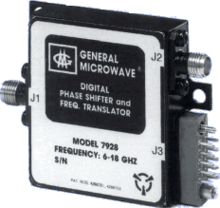Phase shift module
A phase shift module is a microwave network module which provides a controllable phase shift of the RF signal.[1][2][3] Phase shifters are used in phased arrays.[4][5][6]

A microwave (6 to 18 GHz) Phase Shifter and Frequency Translator
Classification
Active versus passive
Active phase shifters provide gain, while passive phase shifters are lossy.
- Active:
- Applications: active electronically scanned array (AESA), passive electronically scanned array (PESA)
- Gain: The phase shifter amplifies while phase shifting
- Noise figure (NF)
- Reciprocity: not reciprocal
- Passive:
- Applications: active electronically scanned array (AESA), passive electronically scanned array (PESA)
- Loss: the phase shifter attenuates while phase shifting
- NF: NF = loss
- Reciprocity: reciprocal
Analog versus digital
- Analog phase shifters provide a continuously variable phase shift or time delay.[7]
- Digital phase shifters provide a discrete set of phase shifts or time delays. Discretization leads to quantization errors. Digital phase shifters require parallel bus control.
- Differential, single-ended or waveguide:
- Differential transmission line: A differential transmission line is a balanced two-conductor transmission line in which the phase difference between currents is 180 degrees. The differential mode is less susceptible to common mode noise and cross talk.
- Antenna selection: dipole, tapered slot antenna (TSA)
- Examples: coplanar strip, slotline
- Single-ended transmission line: A single-ended transmission line is a two-conductor transmission line in which one conductor is referenced to a common ground, the second conductor. The single-ended mode is more susceptible to common-mode noise and cross talk.
- Antenna selection: double folded slot (DFS), microstrip, monopole
- Examples: CPW, microstrip, stripline
- Waveguide
- Antenna selection: waveguide, horn
Frequency band
One-conductor or dielectric transmission line versus two-conductor transmission line
- One-conductor or dielectric transmission line (optical fibre, finline, waveguide):
- Two-conductor transmission line (CPW, microstrip, slotline, stripline):
- Differential or single-ended
- TEM or quasi-TEM mode is TTD or quasi-TTD
- Phase shifters versus TTD phase shifter
- A phase shifter provides an invariable phase shift with frequency, and is used for fixed-beam frequency-invariant pattern synthesis.
- A TTD phase shifter provides an invariable time delay with frequency, and is used for squint-free and ultra wideband (UWB) beam steering.
Reciprocal versus non-reciprocal
- Reciprocal: T/R
- Non-reciprocal: T or R
Technology
Design
- Loaded-line:
- Distortion:
- Distorted if lumped
- Undistorted and TTD if distributed
- Distortion:
- Reflect-type:
- Applications: reflect arrays (S11 phase shifters)
- Distortion:
- Distorted if S21 phase shifter, because of 3 dB coupler
- Undistorted and TTD if S11 phase shifter
- Switched-network
- Network:
- High-pass or low-pass
- or T
- Distortion:
- Undistorted if the left-handed high-pass sections cancel out the distortion of the right-handed low-pass sections
- Network:
- Switched-line
- Applications: UWB beam steering
- Distortion: undistorted and TTD
- Vector summing
Figures of Merit
- Number of Effective bits, if digital [Bit]
- Biasing: current-driven, high-voltage electrostatic [mA,V]
- DC power consumption [mW]
- Distortion: group velocity dispersion (GVD) [ps/(km.nm)]
- Gain [dB] if active, loss [dB] if passive
- Linearity: IP3, P1dB [dBm]
- Phase shift / noise figure [deg/dB] (phase shifter) or time delay / noise figure [ps/dB] (TTD phase shifter)
- Power handling [mW, dBm]
- Reliability [Cycles, MTBF]
- Size [mm2]
- Switching time [ns]
gollark: I thought that was still unstablinated or something?
gollark: Humans have many !!fun!! fallacies.
gollark: It's probably more sunk cost fallacy than actual Stockholm syndrome.
gollark: OOP bad, apioid.
gollark: Ah, I see.
References
- Microwave Solid State Circuit Design, 2nd Ed., by Inder Bahl and Prakash Bhartia, John Wiley & Sons, 2003 (Chapter 12)
- RF MEMS Theory, Design and Technology by Gabriel Rebeiz, John Wiley & Sons, 2003 (Chapter 9-10)
- Antenna Engineering Handbook, 4th Ed., by John Volakis, McGraw-Hill, 2007 (Chapter 21)
- Phased Array Antennas, 2nd Ed., by R. C. Hansen, John Wiley & Sons, 1998
- Phased Array Antenna Handbook, 2nd Ed., by Robert Mailloux, Artech House, 2005
- Phased Array Antennas by Arun K. Bhattacharyya, John Wiley & Sons, 2006
- Microwave Phase Shifter Archived 2003-03-27 at the Wayback Machine information from Herley General Microwave
External links
- Website on Phase Shifters in Microwaves
- Microwave Phase Shifter information from Herley General Microwave
- A low cost electro-mechanical phase shifter design, including a brief summary of solid state methods @ www.activefrance.com
This article is issued from Wikipedia. The text is licensed under Creative Commons - Attribution - Sharealike. Additional terms may apply for the media files.